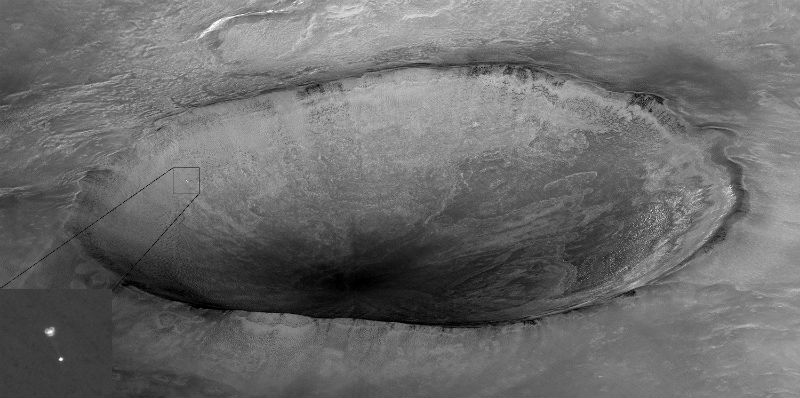27th May 2008
I didn't get much sleep on Sunday night. NASA's Phoenix lander was due to land in the arctic wastes (68 degrees N) of Mars, and what with staying up late to watch podcasts and then waking up in the wee small hours to see the first images I was rather bleary-eyed for Bank Holiday Monday. As a geologist on the Beagle2 project I've experienced the pain when your lander heads down towards the surface and is never heard from again, so I was immensely pleased that Phoenix made it.
 MRO's HiRISE camera acquired this dramatic oblique image of Phoenix descending on its parachute. Shown here is a a wider view of the full image, showing a 10 kilometer diameter crater informally called "Heimdall" and an improved full-resolution image of the parachute and lander.
MRO's HiRISE camera acquired this dramatic oblique image of Phoenix descending on its parachute. Shown here is a a wider view of the full image, showing a 10 kilometer diameter crater informally called "Heimdall" and an improved full-resolution image of the parachute and lander.
Phoenix landed in a flat wasteland of 'patterned ground', traversed by inresecting grooves marking out a polygonal pattern that is well-known on Earth where there is ice at a shallow depth below the surface. One of the main tasks of Phoenix will be to use its 8 ft long robotic arm to dig for this ice so it can be analysed to look for traces of life.
The landing site was chosen to be devoid of large rocks, because those could have endangered the lander. However, there are many pebbles scattered around whose variety intrigues me, as a geologist. Some are faceted as if by wind, some are strongly pitted like frothy lava or as if small spherules have been plucked out, some are rounded as if they underwent prolonged transport by water before they arrived here, and others are slabby and may simply be broken chunks of local, hardened, soil. Possibly the wind has carried so much dust away that these pebbles have become concentrated as a residue on the surface. We have seen only a fraction of the full panorama as yet, and there may be surprises still to come.
Fascinating as the surface images are (at least to me, although I see that today's Sun disagrees We went to Mars and all we got was this lousy photo.... ) the picture that really took my breath away was one sent back by Mars Reconnaissance Orbiter that spotted Phoenix hanging below its parachute on its way down. I wish we'd had such a view of Beagle2 - then at least we'd know how far it reached before things went wrong.

A panorama stitched together of the first images sent back by Phoenix - click for larger version
- This article was updated in August 2017 with better quality images




Rate and Review
Rate this article
Review this article
Log into OpenLearn to leave reviews and join in the conversation.
Article reviews